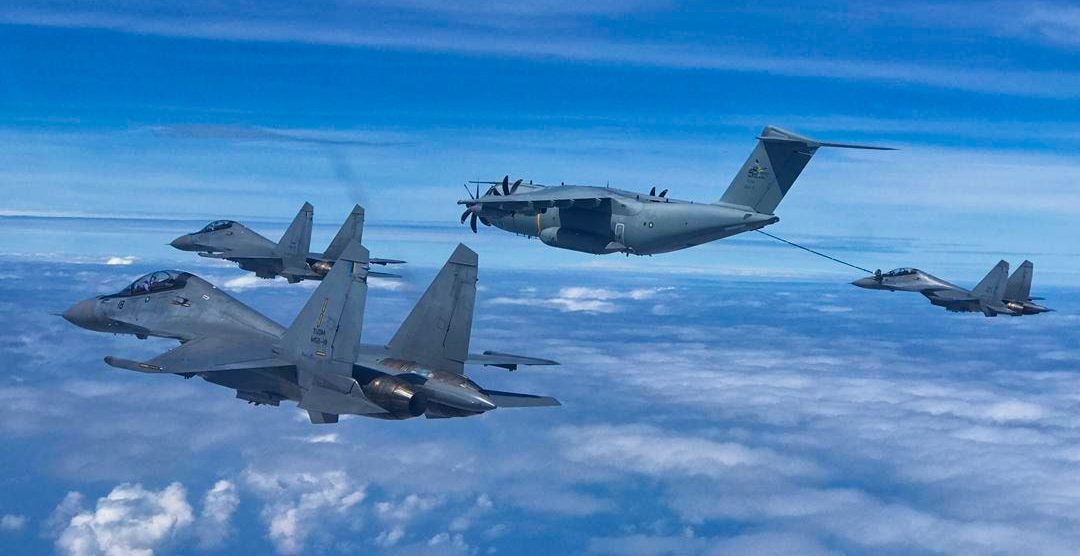
SHAH ALAM: Atlas Refuels Flanker. RMAF has published pictures of an Airbus A400M Atlas refueling a Sukhoi Su-30MKM Flanker, on its Facebook page.
This was the first time, RMAF had shown the compatibility of the Flanker with the A400M Chobham’s refueling pods although Malaysian Defence had reported that Flanker had been cleared with the Boeing Super Hornet F/A-18D Hornet and BAE Systems Hawk 208 to perform AAR on the Atlas.
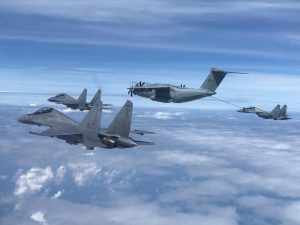
RMAF Atlas conducting air to air refueling with a Flanker. RMAF
From RMAF.
In-flight refueling is the process of transferring aviation fuel from one military aircraft to another during flight.
Tactical locations are often long distances from supporting airfields, which means aircraft may require refueling midflight. Operating a specialized from A400M, In-flight Refueling Specialist pump jet fuel into aircraft in need of fuel. These highly trained experts must have a steady hand and nerves in order to complete this remarkable and crucial task so we can continue to successfully complete all of our missions.“Enroute In-flight Refuelling performed by Su30MKM from No 11 Sqn over South China Sea in support of East Malaysia Operation.”
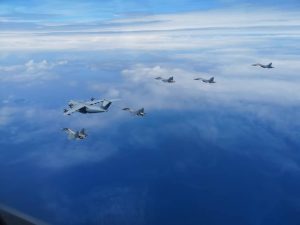
The air to air refueling picture was taken as six Flankers from the 11th Squadron flew from the Gong Kedak airbase to Labuan airbase together with the Atlas. It is conceivable that some of the Flanker drivers need to be certified with air to air refueling hence it was performed underway.
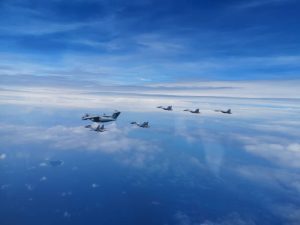
The Flankers, according to RMAF, are in Labuan for their annual live firing exercise at the Kota Belud air to ground range. The exercise, not named, starts from July 28 to August 9, according to RMAF. RMAF said the firing exercise – air to air as well as air to ground – will also involved the Hornets. The A400M will also be used together with the C-130H Hercules for transport and supply though for AAR, it will be done solely by the Atlas. The Beechcraft B200T will be used for range clearance, together with ships from the RMN and APMM, likely for the air to air firings.
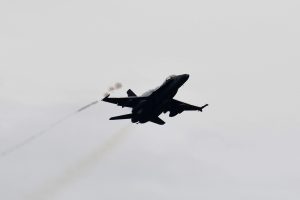
It is unclear what kind of ordnance will be used during the exercise though missiles are likely to be used during the air to air phase. The last time I went to the Kota Belud range the Flankers dropped Russian general purpose bombs, the Hornets 20mm guns and the Hawks, rockets.
–Malaysian Defence
If you like this post, buy me an espresso. Paypal Payment

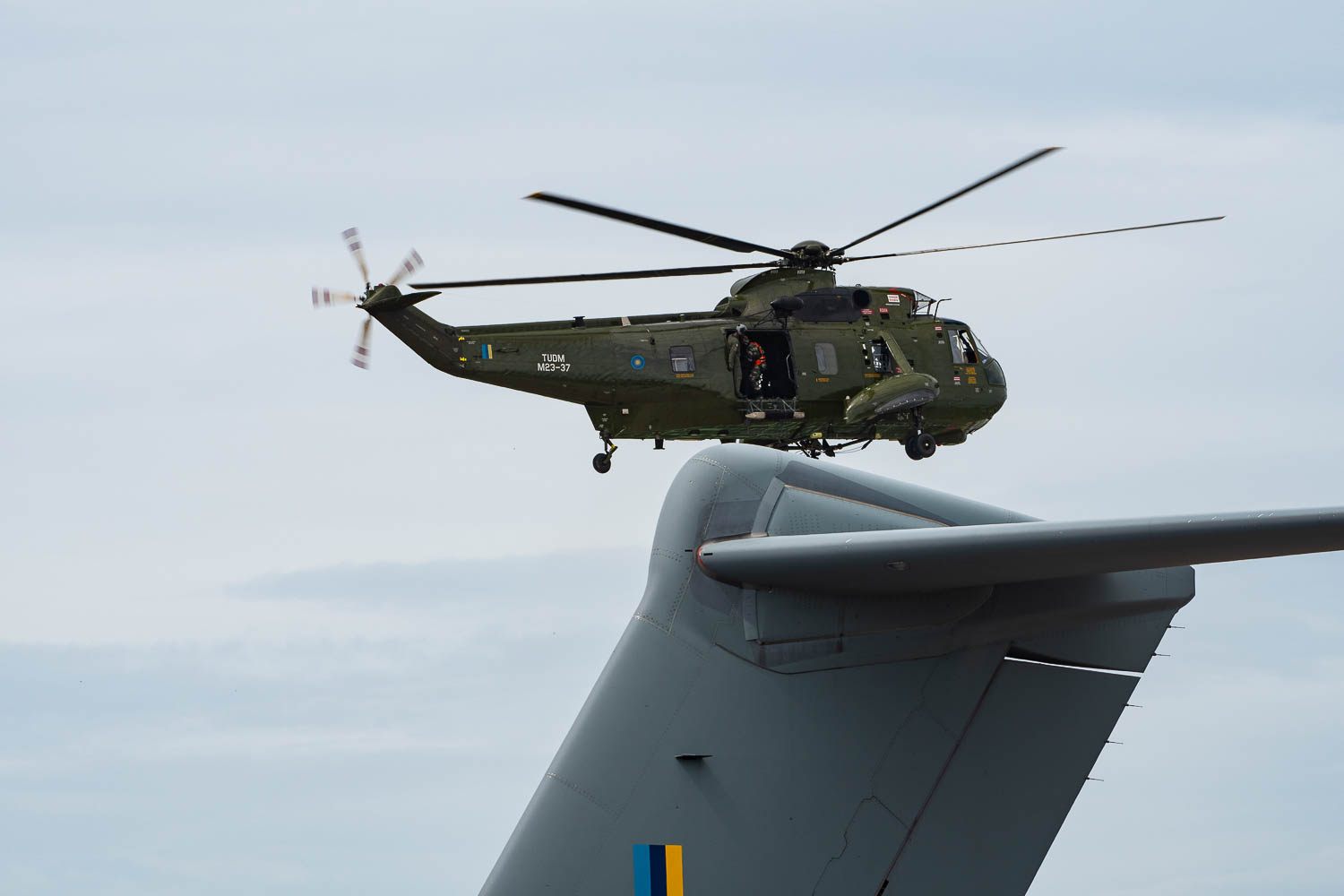
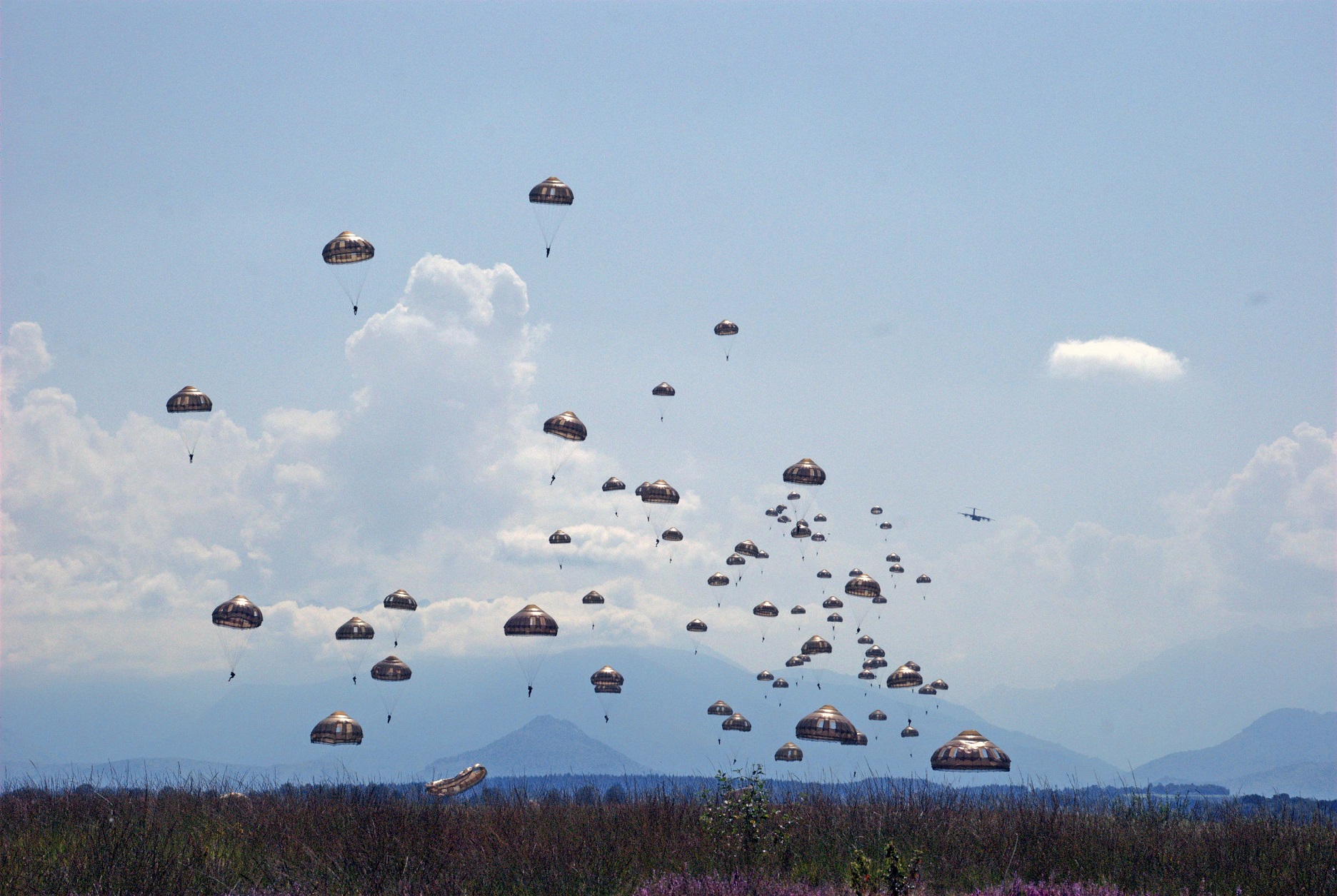
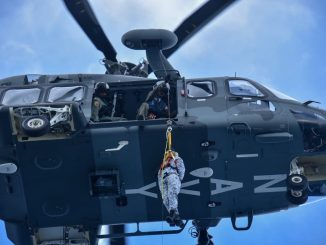
Great pictures from TUDM!
Thanks for sharing them.
On the deployment.
I believe the MKMs are more than capable to fly non-stop to labuan from gong kedak without refuelling. This is just for in flight refuelling recurrency and a chance for a great photo ops! The A400M main task is probably to transport ground suppport equipment of the MKMs to Labuan.
How does the refuelling probe will effect the aircraft structure? Does the aircraft are fit enough to withstand all the extra load? İs it made to carry the refuelling probe?
Reply
Not much affect on the Flanker.
The Atlas was designed from the start to do air to air refueling. It is still unable to do AAR for helicopters which was a requirement. It is likely the French are getting C130J for helicopters AAR
The MKMs certainly have the internal fuel capacity for direct flights to Labuan (they were after all designed for long range interceptions and to escort Soviet bombers from the Kola Peninsular all the way past the Norwegian coast into the North Sea) but depending on the circumstances (I.e. whether it’s an operational tasking, a ferry flight and whether it’s carrying any loads) they might not fly with full tanks.
No doubt the A400Ms will be used to ferry gear to support MKM deployments to Labuan but it’s hoped that some parts are already stocked in Labuan. Therein lies a major problem when one operates different types. If we only operated a single type; the prepositioning of spares and ordnance at various bases would be much easier.
In times of conflict if Butterworth was hit and Hornets returning from a sortie had to divert to Gong Kedak: this would be a problem as Gong Kedak (unless we had catered for the eventuality – unlikely given our resources) would not have any parts, ordnance and support personnel to turn around the Hornets.
“this would be a problem as Gong Kedak (unless we had catered for the eventuality – unlikely given our resources) would not have any parts, ordnance and support personnel to turn around the Hornets.”
True. In theory we can “cross” preposition items for at least some types, but given the modest quantities we buy of most things, it might not be worthwhile (or even possible).
This situation will only get worse when we introduce yet another type in the LCA. If it comes from one of our current suppliers then it might have some parts and procedures in common, if it comes from an entirely different country we can forget about this.
“unlikely given our resources”
An indication of our resources would be the delay in overhauling the MKMs.
@ AM
The situation does not get worse with LCA. Actually it will improve as the LCA will eventually replace 3 types of platform (MB-339, hawk, MiG-29).
Another note
Our MKM also can function as a tanker. Although other air forces uses russian AAR pod with their flanker, our MKM uses cobham AAR pod not unlike those on the KC-130H and A-400M.
https://www.malaysiandefence.com/wp-content/uploads/2010/10/budyre.jpg
“Actually it will improve as the LCA will eventually replace 3 types of platform (MB-339, hawk, MiG-29).”
Yes, assuming we buy enough to meet our operational and training requirements to replace existing types at the outset.
Otherwise, our existing trainers and attack platforms will have to soldier on until the day comes that we have bought sufficient numbers of LCA, if it comes at all.
It also assumes that the RMAF is satisfied with the LCA in the roles intended for it- capabilities, availability, cost effectiveness and so on. We’ve seen how some types did not live up to expectations which led the RMAF to rely on other, in some cases older, types.
The Cobhams were bought to enable MKMs on operational sorties to do circuitous routes on their way to the target. This would require more fuel that flying in a straight line, especially when loaded with ordnance.
…, – “The situation does not get worse with LCA”
It doesn’t go away with the fact that we’ll still have Hornets, MKMs and LCAs : all different types, requiring different spares/parts.
It’s good that the LCA will replace certain types but the harsh reality is that we’ll still have to stock on the different spares/parts needed and that if any particular type has to operate away from it’s home base for extended periods; this will be a problem – unless we had the time to plan accordingly. Yes
Now of course the way around this would be to operate a single combat type. This would solve a lot of problems but we still desire a high/low end mix and our policy is to not be too reliant on one supplier.
@ Azlan
Even if we do away with LCA, we would still need a LIFT platform.
We need LCA because of operating cost constraints. We would probably be good if we just have 1 fighter type, but as a country that is mainly non
aligned, we need to hedge our bets. Compunded with our unique situation straddling 2 sides of the south china sea, we also need something with long endurace, something the MKM has.
Even if we reduce our types to just 3 (LCA/LIFT, MRCA, MKM) it is still not as many as our neighbours such as thailand and indonesia.
I should add that we buy a modest amount of parts and ordnance not only because of budget constraints, but because we operate only 8 or 18 of X type. When each of our fleets is so small, it’s hard to justify a large inventory, one that can be worthwhile prepositioning at other bases.
At this point, we don’t yet know how many aircraft there will be in the initial batch of LCA, when a follow on batch will come or if it will come at all, or if batch 2 will have different specs from batch 1.
As I said, it is too early to predict that we will have the “luxury” of retiring older types even after the LCA enters service.
AM,
I couldn’t agree more.
Same also applies to the RMN. By the time we get around to actually signing for 2 more subs; how old will the initial 2 be and what’s level of commonality will we have? Will the OEM still be producing improved Scorpene derivatives?
Plans like CAP55 and 5/15 look great on paper. Who can disagree with long term planning that creates costs savings and increases commonality? The reality unfortunately is very different; especially when there’s a lack of urgency and political will and when things can change due to various factors.
The 4 LMSs are a good example of how the 5/15 will not be the 5/15 any longer; something which I’ve long expressed concern about.
@Marhalim
Are the A400Ms cleared to do AAR from one to the other? Would be a great photoshot if they could refuel one A400M with another.
Reply
It is but I am not sure whether RMAF needs or wants to
@Azlan
5to15 and CAP55 was planning initiatives born in the previous administration. While CAP55 is just pie in the sky, 5to15 was certainly viable and had strong backing from the Government. With the change this doesn’t apply anymore, so the new admiral and air general need to go back the drawing board and come out with a new plan for the long term (that is, if the current administration could last long enough, if they don’t then rinse and repeat again).
joe,
5/15 was a plan born out of desperation due to the reality that a number of assets that were long overdue for replacement were not likely to be replaced anytime soon – the RMN was in a much more critical position compared to the RMAF; both were/are under resourced and overstretched but the RMAF – unlike the RMN – did not have the problem of having assets that were long past their retirement date.
Thus the RMN came out with the idea to generate cost savings by retiring some aged increasingly expensive to maintain ships; with those savings (from maintenance and upkeep) being channelled to new ships. That’s how the idea was sold. At first it met with opposition from the bureaucrats (no strong backing as you claim) and took the PM’s direct intervention to make it happen. Even the deal for the LMSs was stuck initially with bureaucratic red tape.
As I’ve pointed out before the 5/15 looks great on paper but is subject to factors beyond the RMN’s control; like changes in politics, threat perceptions, etc. Thus it’s really not as “viable” as you claim. Even within the RMN it met with deep reservations.
Also, a change in government doesn’t necessarily mean the 5/15 is dead: the government and RMN – officially – are both – for now – maintaining the course but for different reasons : the RMN because it has no alternative at present and the government because it’s unwilling to allocate funds and hasn’t come around to focusing on defence.
The 5/15 can only work if the government has the political will to make firm commitments and if the plan is not stretched over too long a period. Buying subs in 10-20 years will mean they have no commonality with the Scorpenes; contrary to the 5-15 which after all is/was intended to increase commonality and reduce the logistical/support footprint. Same goes with the LCSs and LMSs.
@ azlan
IMO the government need to give clear assurance on the defence budget for at least the next 2 rancangan malaysia. That is the most important item to be mentioned in the Defence White Paper. Only then the services can plan for their future.
Overall the 15 to 5 plan, although not perfect, is a thoroughly comprehensive and well thought of. Every single task and capability is put into paper. The not perfect part is the very disjointed build plan, and no clear out of service date (OSD) for the submarines, lekius and kasturis.
At least it is way better than what the air force came out with, which is now a big joke among our neighbouring country defence forums.
Reply
The air force said that they come out with the plan based on their experience with the government funding practices.
@ marhalim
Of course all plans are done based on experience.
But where actually is the plan?? All we see is what they want by 2055. No RMK by RMK plan, capability and task list like what the TLDM 15 to 5 plan is. If there is anything on the CAP55 half as good as the TLDM 15 to 5 plan, i would love to read it.
@Azlan
Necessity are always born out of desperation, but certainly Adm Kamarul took charge of the fact that his Forces are facing block obsolesce though not in his time at the helm. It was made viable because it sounded reasonable and more importantly doable if it continues past his time.
The bureaucrats have their own reasons for not being on board, mostly it was a novel idea and the old fogies are adverse to anything new that doesn’t benefits them. In any case, there is no stronger political backing than the PM himself so take it what you will.
While global threat perception changes often, it is the military role to forecast the changes and equip for the foreseeable change. It is a mid-long term planning, so we can’t be changing hardware every few years if the situation changes from time to time. We don’t have the money & resources for it.
They are continuing the course because they have no choice right now but in time things might began to unravel and the plan no longer doable, so its up to Adm Dato Reza to foresee this change as well and retweak or replan if necessary.
The existing subs can be upgraded to the current standards during long refits (this is what being done in other navies) so I don’t see why we shouldn’t continue buying newer versions of current hardwares we have.
@…
Which is why I said CAP55 is more like a Christmas wishlist and not a plan on how to get what they wanted.
…. – “Overall the 15 to 5 plan, although not perfect, is a thoroughly comprehensive and well thought of. Every single task and capability is put into paper”
Like I keep saying; it looks great on paper. Who can argue with long term planning which results in greater communality and in costs savings? The 2 reservations (when the plan was announced) was whether it could actually be carried out and whether it would provide the RMN with the capabilities it needs in the long to medium term.
Of course the government needs to give a firm indication as to when funding will be provided and also to provide some level of commitment (that will simplify things greatly for both the armed services and the local industry) but chances of that happening are unlikely.
@ azlan
Although there are reservations, at least the 15 to 5 is clearly a plan, a very comprehensive one at that. The same cannot be said for the CAP55.
….
If you think so.
joe – “(this is what being done in other navies) so I don’t see why we shouldn’t continue buying newer versions of current hardwares we have”
“Other” navies don’t buy boats followed by the purchase of other boats in say 10 or 20 years and expect them to have broad commonality. They don’t.
You might not be able to “see” why one would want follow on batches of subs or ships to have improvements over what is presently operated and contains systems/components from 10 years or more earlier but they do. It’s called “moving with the times” (to use a cliche); progressively improving on what one already has in order to get better capabilities over systems that might be obsolete or unable to meet with current requirements.
@Azlan
Military hardware are long lived but that doesn’t mean they don’t get progressively updated with new techs & features. However these advances are usually introduced in so called Tranche or Blocks.
Let’s say you have Block 10 F-16s and 10 years later you intend to buy more F-16s but now they come as Block 30s, you might have concerns on incompatibilities between the Blocks but Lockheed has the capability to upgrade those old Block 10s to Block 30 standard, bring both old and new to the same standards. Though I will add there is a certain time frame in between where this is viable (much like the F-16 example, we can’t expect 1970’s Type A be upgradeable to the latest Type V variant).
Incremental updates are key to the longevity of Western hardware. If we can’t managed that, we should just go for Russian hardware.
Joe – “Military hardware are long lived but that doesn’t mean they don’t get progressively updated with new techs & features”
Let’s not complicate things and go off plot. I’m saying that one reason why the 5/15 is not viable is because of the uncertainty with regards to the time factor when it comes to procuring follow on batches of what we already have. If we take too long to procure follow batches of say the LCS and subs; naturally these will contain various improvements over the initial batches, which means that there will be less commonality.
That in turn means that we’ll be operating different systems that will in turn increase the logistical footprint which is contrary to what the 5/15 was intended to achieve. Period/full stop. Nobody suggested that military gear isn’t progressively upgraded so you’re just stating the obvious.
joe – “example, we can’t expect 1970’s Type A be upgradeable to the latest Type V variant”
You’re just stating what I have already mentioned and what I meant when I wrote this : “Other navies” ;your quote) don’t buy boats followed by the purchase of other boats in say 10 or 20 years and expect them to have broad commonality. They don’t.
Again – in our case wait too long and the gulf between what we have now and will get later will only increase. Wait too long and whatever boat we build will be totally different to what we have now due to advances in technology and the fact that the OEM will no longer be producing Scorpene derivatives.
joe – “Incremental updates are key to the longevity of Western hardware. If we can’t managed that, we should just go for Russian hardware.”
Incremental updates are the key to all hardware irrespective of where they’re from. I have no idea where you got the impression that it applies only to Western gear.
Take the MKMs for example, by right they should be upgraded now to replace the various components/systems they came with; “components/systems that were first designed in the 1990’s. Also, if we ever get follow on batches of MKMs naturally these will contain various improvements (whether in the form of an AESA, improved avionics or newer EW kit) and to simplify things from a support perspective the initial MKMs should – as far as possible – be brought to the same standard as the follow on ones.
joe – “While global threat perception changes often, it is the military role to forecast the changes and equip for the foreseeable change” Thanks for the heads up but all I mentioned is that the 5-15 (which commits the RMN to a specific plan whilst limiting other options) falls under the danger of changes to politics, threat perceptions, etc.
BTW it is the armed services which plan accordingly to changes in threats and priorities but it is the government which decides on whether a change of course is warranted .
joe – “you might have concerns on incompatibilities between the Blocks but Lockheed has the capability to upgrade those old Block 10s to Block 30 standard”
Right and if we take into account the Scorpenes we have at present and one’s we’ll buy in 10 years or more; given rapid advances in technology and the fact that various components on the Scorpenes will be obsolete or obsolescent by then; the new sub will have different sonars, CMS, propulsion, batteries, mast, etc.
It would help tremendously and make the 5/15 more viable and realistic if subs were bought sooner; this would enable some level of commonality, even taking into account a sub bought in a few years – rather than 10 or 20 – will have different components.
The same applies to the LCSs. Wait to long and it might not make sense for follow on LCS batches to be fitted out to a similar level, even if it was possible. Yes, we can have follow on LCSs and call them Batch 2s. Both after all will still be of the same class but fitted out differently will require a separate shore support infrastructure.
Hence my earlier statement (here and in other threads) that the 5/15 is only viable if the government can make some level of commitment. Let’s hope the cock up with LMSs (a class of just 4 overpriced ships that probably will not deliver the capability desired and will require another class of “LMSs) is not a sign of things to come.
@ azlan
I agree with you on that. The same reason why i wrote an alternative 15 to 5 plan here on malaysiandefence.
You cannot spread supposedly common ships far and wide, even skipping a few RMK.
… – “You cannot spread supposedly common ships far and wide, even skipping a few RMK”
I pointed this out when we had our first round of discussions on the 5/15 a year or so ago. In fact we can’t do it with anything, not just ships. Not with aircraft, not with AFVs.
The reason the 15/5 is spread out over so long a period is to make it more appealing to the government. If it was too ambitious or spread over a shorter period the plan might have been rejected outright.
In the next 2-3 years lets see if the MRSSs get funded. IMO that will give us some indication of how committed the government is. Also lets see over the next few years as to the direction the RMN is able to go with regards to a follow on class of fully fitted out LMSs.
@ azlan
The plan can be spread out, no issues. But buys need to be in one time, or in a series one after another if possible.
For example, i would prefer the gowind batch 2 to be right after the 1st one completed. LCA/LIFT to be bought at 1 go. A 2nd batch of gempitas in the next RMK while the line is hot.
As for the MRSS, if there is no budget for it next RMK, why not look at used? The San Giorgios are for sale in very near future. Putting 1st priority on Gowind 2nd batch and having san giorgios for MRSS is IMO a palatable compromise to be taken. More budget would be available if the kedah batch 2 is forgotten altogether and OPV task be done by MMEA.
“Used” is good but it depends.
The main reason the RMN needs to replace the Saktis is not only because it needs a more capable/flexible design but because of the age factor : becoming increasingly maintenance intensive which in turn means higher costs.
The RMN will be very cautious and reluctant to get any pre owned hulls if the costs of maintaining these hulls for the remainder of their service lifestyle is prohibitively expensive. Who’s to say that any pre owned hull we get – irrespective of its good condition – will not be as problematic as expensive to run as the Saktis? It is for this reason that offers for pre owned hulls were rejected in the past.
The plan can indeed be “spread out” but not “spread out” over too long a period. If the RMN has to scale down its requirements in order for the plan to be implemented over a shorter period; this might be a price worth paying.
Reply
I think it’s better to fund one LCS a year , one MRSS every 1 and half year and two years for the Scorpene replacement.
@ marhalim
No can do. Our budget is to small to do what you want to do.
At most the budget for TLDM would be USD2 billion for a 5 year Rancangan Malaysia.
If following your plan in 5 years we would have bought
5 LCS – usd2.3 billion
3 MRSS – usd 300-450 million?
2 scorpenes – usd1 billion
That is at least usd3.6 billion. That cannot be afforded and the reason why we have to spread out our buy, and think about used equipment for some of our requirements.
Anyhow lets wait a few more months to see if the government can really commit a stable development funding written in the defence white paper. Probably then i can do a take 3 on the 15 to 5 plan.
Back on the topic of the flankers.
Russia has announced that the latest batch of Su-30SM called the Su-30SMD is being built with the article 117S engines, which is the same engines as the Su-35.
http://www.interfax.ru/russia/668996
On the other hand,
India has just ordered emergency stocks of software-defined radios (SDR) from israel for its MKI and other fighters, after finding its current radios was easily jammed by pakistani forces.
http://www.timesnownews.com/india/article/iaf-to-buy-sdrs-from-israel-to-ensure-secure-communication-between-fighter-jets/461569
TUDM Su-30MKM on the other hand is equipped with SDR from the start (our MKM uses the Rohde & Schwarz M3AR SDR tranceiver).
Secure communications with SDR is a common equipment within all of our armed forces, even to individual soldier level. We even build some of the SDR locally by Sapura. Some little things that we do that while not as grand as stealth fighters or latest MBTs, but just as important in overall defence picture of our country.
As we hesitate to sell our MiG-29N to india, they have instead asked russia to sell 21 used MiG-29.
An opportunity lost.
http://www.economictimes.com/news/defence/iaf-in-talks-with-russia-for-urgent-mig-29-purchase/articleshow/67968978.cms
http://faujireporter.com/blogs/2019/07/11/india-to-buy-18-more-su-30mki-and-21-html/